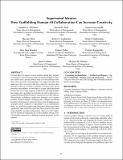| dc.contributor.author | Heyman, Jennifer | |
| dc.contributor.author | Rick, Steven | |
| dc.contributor.author | Giacomelli, Gianni | |
| dc.contributor.author | Wen, Haoran | |
| dc.contributor.author | Laubacher, Robert | |
| dc.contributor.author | Taubenslag, Nancy | |
| dc.contributor.author | Knicker, Max | |
| dc.contributor.author | Jeddi, Younes | |
| dc.contributor.author | Ragupathy, Pranav | |
| dc.contributor.author | Curhan, Jared | |
| dc.contributor.author | Malone, Thomas | |
| dc.date.accessioned | 2024-08-02T16:29:21Z | |
| dc.date.available | 2024-08-02T16:29:21Z | |
| dc.date.issued | 2024-06-27 | |
| dc.identifier.isbn | 979-8-4007-0554-0 | |
| dc.identifier.uri | https://hdl.handle.net/1721.1/155927 | |
| dc.description | CI ’24, June 27–28, 2024, Boston, MA, USA | en_US |
| dc.description.abstract | Previous efforts to support creative problem-solving have included (a) techniques such as brainstorming and design thinking to stimulate creative ideas, and (b) software tools to record and share these ideas. Now, generative AI technologies can suggest new ideas that might never have occurred to the users, and users can then select from these ideas or use them to stimulate even more ideas. To explore these possibilities, we developed a system called Supermind Ideator that uses a large language model (LLM) and adds prompts, fine tuning, and a specialized user interface in order to help users reformulate their problem statements and generate possible solutions. This provides scaffolding to guide users through a set of creative problem-solving techniques, including some techniques specifically intended to help generate innovative ideas about designing groups of people and/or computers (“superminds”). In an experimental study, we found that people using Supermind Ideator generated significantly more innovative ideas than those generated by people using ChatGPT or people working alone. Thus our results suggest that the benefits of using LLMs for creative problem-solving can be substantially enhanced by scaffolding designed specifically for this purpose. | en_US |
| dc.publisher | ACM|Collective Intelligence Conference | en_US |
| dc.relation.isversionof | 10.1145/3643562.3672611 | en_US |
| dc.rights | Creative Commons Attribution | en_US |
| dc.rights.uri | https://creativecommons.org/licenses/by/4.0/ | en_US |
| dc.source | Association for Computing Machinery | en_US |
| dc.title | Supermind Ideator: How Scaffolding Human-AI Collaboration Can Increase Creativity | en_US |
| dc.type | Article | en_US |
| dc.identifier.citation | Heyman, Jennifer, Rick, Steven, Giacomelli, Gianni, Wen, Haoran, Laubacher, Robert et al. 2024. "Supermind Ideator: How Scaffolding Human-AI Collaboration Can Increase Creativity." | |
| dc.contributor.department | Sloan School of Management | |
| dc.identifier.mitlicense | PUBLISHER_CC | |
| dc.eprint.version | Final published version | en_US |
| dc.type.uri | http://purl.org/eprint/type/ConferencePaper | en_US |
| eprint.status | http://purl.org/eprint/status/NonPeerReviewed | en_US |
| dc.date.updated | 2024-08-01T07:48:06Z | |
| dc.language.rfc3066 | en | |
| dc.rights.holder | The author(s) | |
| dspace.date.submission | 2024-08-01T07:48:07Z | |
| mit.license | PUBLISHER_CC | |
| mit.metadata.status | Authority Work and Publication Information Needed | en_US |
